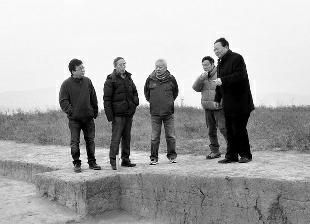Royal heaven found in Qin and Han dynasties in Shaanxi Province for more than 700 years
 Fengxiang County, South of the city caused a archaeological excavation of Qin Han ruins of archaeological field
Fengxiang County, South of the city caused a archaeological excavation of Qin Han ruins of archaeological fieldCircular mound found era is currently the oldest temple of heaven, the site Phong tho
For more than 700 years, "Qin Huang and Han Wu" are here worship
More than 1900 pieces unearthed (groups) such as jade, yuhuang, small horses and sacrificial relics
Huashang News (reporter Baghy) under the mountain, Hill, civil engineering. Recently, thanked the South caused a archaeological excavation of Qin Han ruins of archaeological circles, experts to the site's geographical location, site characteristics, think this is one of the Qin and Han dynasty Royal Festival site, found the circular mound site Phong tho is currently the age of discovery the earliest ruins of the Temple of heaven. Experts, it is used in the Qin and Han dynasties for more than 700 years, "Royal heaven."
Witnessed for more than 700 years of Qin and Han Yong zhi played site ceremonies
Sion blood pool located in Fengxiang County, Liu Lin Zhen Banpo Village, five joint teams and local cultural departments, targeted excavations on the site.
As the excavation proceeds, a number of important monuments and ancient sacrificial relics in front of archaeologists. Most significantly of remains is Phong tho altar, addition also has Wei (w é I, ancient altar around of short wall), and altar field and three Gai, and building site, and road, and horse cattle sheep pit,, also excavations unearthed has more than 1900 pieces (Group) such as jade people, and yuhuang, and demanded, and small I car horse, and car horse device, specifically for sacrifice of heritage, and Qin Han period of building materials as panwa, and tile,.
Experts, this is a use for more than 700 years, Yong zhi played sites used in sacrificial ceremonies. From 220 BC to Emperor Cheng and finally a trip to Qin Shi Huang Yong and ritual activities, Gu Yong to witness the Qin and Han dynasties over more than 700 prominent Festival, became emperor in Qin and Han I pray gods blessings, in other words, Qin Shihuang, the Emperor the Emperor of all sacrificial activities have been doing here.
Yong zhi played culture remains as the highest grade of the State of Qin and Han dynasties product of sacrifices, is part of the China etiquette culture, Yong zhi played cultural relics has become several generations of archaeologists in issues of common concern. However, the recorded history although there are sacrifices, but the "Zhi played" the location where? For decades, archaeologists in Fengxiang County, several times looking for but never find "Zhi played" the exact location. Archaeologists investigating Yong building adjacent to the site of the Han dynasty when a circular mound Phong tho, due to its special geographical location, attracted a lot of attention, then targeted excavations.
Era's first biggest longest "Royal heaven"
Sion blood pool site in recent years in yongcheng city to explore the Qin and Han dynasties "Zhi played" remains one of the most important discoveries. Sion of sacrificial sites found from the current overall structure and landscape features, the Zhi played will be built in the mountains, under a flat platform on top of the Hill, followed by Phong tho the circular mound altar attached to the mountain, and the circular mound found in Phong tho is currently the earliest age of discovery of the site of the ruins of the Temple of heaven.
According to the site's geographical location, site features, ancient and modern inspiration of place names and other clues, combined with documents, experts say blood pools site is North of the historical place of Liu Bang Zhi played, is a Royal offering of the Qin and Han dynasties sites.
Chinese Academy of social sciences and academician, Chinese Academy of Social Sciences Institute of archaeology, the original Director, famous archaeologist Liu Qingzhu recently traveled to Sion blood pool site visits. He thinks blood pool sites as an important component of yongcheng, and for a long time people have been hoping by archaeological exploration of a sacrifice on the outskirts district was finally found, this marks the Qin and Han dynasties from the capitals to use the term "Saint" leads interactive confirm the process of archaeological remains.
Liu Qingzhu think, blood pooling on the current ruins and relics that have been unearthed, which records ? the worship book, Han Jing Jiao SI Zhi and other historical documents there are a large number of records, and supreme sacrifice to ceremonial activities of the State in the period of Qin and Han "Zhi played" consistent structure. Therefore, the blood pools the archaeological significance of the site is very important, as the Qin and Han period fixed ritual sites of the countries located in the outskirts of yongcheng, era archaeological finds to date is the earliest, largest, remains the most clear, the longest duration of "Royal heaven."
As archaeological Shang first mass carried out of national sacrifice remains archaeological, on blood pool site of found and excavations, not only is history records in the on in Yong to carried out of series national sacrifice behavior of confirmed, and became from dongzhou Princes country to Qin Han unification national sacrifice activities of most important material carrier and real reflected, Liu Qingzhu think, from "through real see people" of angle, the archaeological excavations out of real information, for deepening Qin Han ritual, and Qin Han political, and Etiquette in ancient China cultural studies is of great academic value. According to the Shaanxi Provincial Archaeological Institute
(Editors: Biao Guo UN832)
2016-12-04 04:23:55
China business daily
陕西发现秦汉时期皇家祭天坛 使用长达700多年
 凤翔县城南一处秦汉遗址的发掘考古引起了考古界关注
凤翔县城南一处秦汉遗址的发掘考古引起了考古界关注 发现的圜丘封土遗址是目前国内时代最早的天坛遗址
使用长达700多年,“秦皇汉武”都曾在这里祭祀
出土1900余件(组)玉人、玉璜、小型偶车马等用于祭祀的文物
华商报讯(记者鲍吉)大山之下,小山之上,封土建坛。近日,陕西凤翔县城南一处秦汉遗址的发掘考古引起了考古界关注,专家据遗址所处的地理环境、遗迹特征等,认为这是一处秦汉时期皇家国祭的场所,发现的圜丘封土遗址是目前国内发现的时代最早的天坛遗址。专家考证,这是在秦汉时期使用长达700多年的“皇家祭天台”。
雍畤遗址见证秦汉700多年祭祀活动
雍山血池遗址位于凤翔县柳林镇半坡铺村五组和当地文博部门联合组队,对该遗址进行了针对性的发掘。
随着发掘工作的进行,一批重要的遗迹与古代祭祀文物呈现在考古工作者眼前。最显著的遗迹就是封土坛,另外还有壝(wéi,古代祭坛四周的矮墙)、坛场与三垓、建筑遗址、道路、马牛羊祭祀坑等,还发掘出土了1900余件(组)诸如玉人、玉璜、玉琮、小型偶车马、车马器等专门用于祭祀的文物,以及秦汉时期的建筑材料如板瓦、瓦当等。
专家考证,这是一处使用长达700多年,用于祭祀的雍畤遗址。从公元前220年秦始皇到汉成帝最后一次前往雍地开展祭祀活动,古雍地见证了秦汉长达700多年显赫的祭祀活动,成为秦汉帝王祈愿神灵保佑的福泽之地,也就是说,秦始皇、汉武帝这些一代帝王都曾在这里做过祭祀活动。
雍畤文化遗存作为秦汉时期的国家最高等级祭祀典礼的产物,是中华礼制文化的组成部分,对雍畤文化遗存的探索成为几代考古学者共同关注的问题。然而,史书上虽然有祭祀的记载,但“畤”的位置究竟在哪里?几十年来,考古工作者虽然在凤翔县进行多次找寻,但是,始终没有找寻到“畤”确切的位置。而就在考古工作者在调查雍地汉代建筑遗址邻近的一处圜丘封土时,由于其所处的特殊地理环境,引起了高度关注,随后展开针对性的发掘。
时代最早规模最大持续时间最长的“皇家祭天台”
雍山血池遗址是近年来在雍城城外探寻有关秦汉“畤”遗存的重大发现之一。从目前发现的雍山祭祀遗址整体结构和面貌特征来看,畤必建于大山之下、小山之上的一处平坦台地,其后依附于山上封土圜丘坛场,而且发现的圜丘封土遗址是目前国内发现的时代最早的天坛遗址。
根据遗址所处的地理环境、遗迹特征、古今地名的启示等线索,同时结合文献资料,专家认为血池遗址就是史料记载汉高祖刘邦所置的北畤,是一处秦汉时期的皇家国祭场所。
中国社会科学院学部委员、中国社会科学院考古研究所原所长、著名考古学家刘庆柱日前专程前往雍山血池遗址考察。他认为血池遗址作为雍城一个重要组成部分,且长期以来被考古人一直寄望探寻的一处郊外祭祀功能区终于被找到,此标志着这座从列国都城到秦汉沿用“圣都”的过程得到考古遗存线索的交互印证。
刘庆柱认为,就目前血池已发掘出土的各类遗迹和遗物来看,它在《史记·封禅书》、《汉书·郊祀志》等历史文献中有大量记载,且为秦汉时期国家最高祭天礼仪活动的“畤”结构特征相吻合。因此,血池遗址的考古工作意义非常重要,它作为秦汉时期国家专门设在雍城郊外的固定祭祀场所,是迄今为止考古所发现时代最早、规模最大、遗存性质最明确、持续时间最长的“皇家祭天台”。
作为考古学上首次大规模开展的国家祭祀遗存考古,对血池遗址的发现和发掘,不仅是正史记载中关于在雍地开展的一系列国家祭祀行为之印证,而且成为从东周诸侯国到秦汉大一统国家祭祀活动的最重要物质载体和实物体现,刘庆柱认为,从“透物见人”的角度,此次考古发掘出的实物资料,对于深化秦汉礼制、秦汉政治、中国古代礼制文化等方面的研究均具有重要的学术价值。 图据陕西省考古研究院
(责任编辑:郭彪 UN832)
2016-12-04 04:23:55
华商报